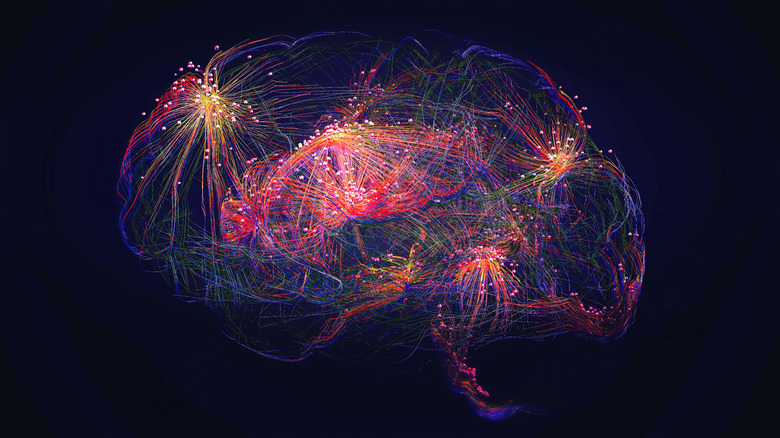The Incredible Map That Shows Every Neuron In The Brain
Neurons are cells in the nervous system that send and receive messages throughout your body, allowing your brain to control everything you do. They're even involved in how your brain processes eating. Since there are about 86 billion neurons in the brain, the synapses that connect them look like an elaborate pile of spaghetti in raw images. Thanks to FlyWire and a consortium of researchers across more than 127 institutions, this chaotic network of circuitry is depicted in the first-ever full connectome of an entire adult female fruit fly brain.
Publishing the collection of flagship and companion papers in scientific journal Nature, the Princeton University-led FlyWire Consortium — which consisted of gamers and professional tracers among neuroscientists — used 21 million high-resolution images from the fly brain and a multistep process with AI and computer automation to untangle the web of undifferentiated neurons. The labeled, three-dimensional map includes around 100,000 cell annotations, almost 140,000 neurons, and more than 50 million synapses — all of which they started in 2019.
The flagship paper's lead author, Dr. Sven Dorkenwald of Princeton University, told Princeton's Office of Communications, "What we have done is build an atlas of the brain, and added annotations for all the businesses, the buildings, the street names. With this, researchers are now equipped to thoughtfully navigate the brain, as we try to understand it." This feat is so amazing because of its complexity to previous brain models, such as the 302 neurons of an adult roundworm and the 3,000 neurons of a larval fruit fly.
Why the fruit fly brain model can aid human neurological research
To the general public, it might not seem very productive toward human neurological research for scientists to work so hard on an insect wiring diagram, but fruit fly brains actually have quite a bit in common with ours. For starters, we share 60% of DNA, including genes for jet lag, learning, and chromosomal abnormalities. The insects serenade love interests, stay awake with coffee, get drunk, age the same, and problem-solve like we do, too. On top of that, 75% of human genetic diseases have similarities with fruit flies.
Currently, many human neurological diseases are incurable — such as Alzheimer's, Parkinson's, and dementia — so doctors are only able to treat the symptoms. Now, researchers will be able to use this brain atlas to understand how all brains function, how neurons connect with one another, and which neurons and behaviors correlate. It will allow them to understand the difference between a healthy and diseased brain, paving the way for tailored treatments. A 2019 study was published regarding how fruit flies could cure chronic pain, for instance, and this new brain model could further that research.
The FlyWire Consortium created a free Codex so that professionals around the world can navigate the comprehensive map without needing advanced tools or downloading excessive amounts of data. More than 10,000 users had registered for it as of early October 2024, and new experiments are already underway. Plus, the team created a collection of resources for high school and college students to learn from, which may expand its application and potential in neurological research.

